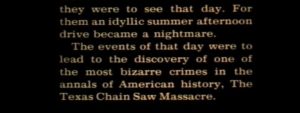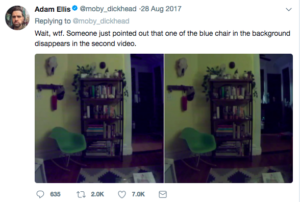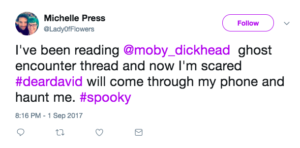Creators of horror fiction have always been interested in finding and using new methods to create the sense of unrelenting immediacy for their readers and/or viewers. As one of the primary goals of gothic and horror texts 1 is to scare its audience, immersion is certainly key. The imaginative world within the horror text must be a world close enough to the one inhabited by the audience so that the two can bleed into one another. Early examples of methods used by horror writers to create immediacy include a note of

authenticity prior to the first chapter which claims that everything described within the story is true 2 or a warning at the start of the film that it depicts a real event 3. When the gothic mode was transported from Europe to the United States, Charles Brockden Brown (among others) realized that the genre needed to be re-worked to fit the “new” American context and urged other American writers to include haunted woods within their gothic tales and novels rather than haunted castles and dungeons.
Rather than incorporating the gothic into a new region, the horror genre today is reforming itself to fit within the digital era 4. The recent film Unfriended (2014) takes place almost entirely on a computer monitor and featured a digital ghost. More importantly to this post, the traditional ghost story has lately been remediated into an entirely digital product. Rather than experiencing horror through the page or screen, fans can now find these narratives on spaces like Creepy Pasta or, perhaps more surprisingly, Twitter.
Digital cartoonist Adam Ellis has spent the last six months continuously adding to a (supposedly real) ghost story titled “Dear David” on his Twitter page 5. Beginning in August 2017, he’s related the story of an  eerie child ghost haunting his NYC apartment through text, photos, and short videos. Bolter and Grusin note that hypermedia “strives for immediacy” despite the fact that “digital technologies of immediacy always end up being remediations” 6. Ellis’s ghost story certainly borrows a number of conventions from the traditional ghost story, including the ghost seeking vengeance, animals being aware of the spirit’s presence, and, most recently, possession. However, all of these recycled plot-lines are remediated and improved upon through the use of digital technology and the hypermediacy created by Ellis’s multimodal project.
eerie child ghost haunting his NYC apartment through text, photos, and short videos. Bolter and Grusin note that hypermedia “strives for immediacy” despite the fact that “digital technologies of immediacy always end up being remediations” 6. Ellis’s ghost story certainly borrows a number of conventions from the traditional ghost story, including the ghost seeking vengeance, animals being aware of the spirit’s presence, and, most recently, possession. However, all of these recycled plot-lines are remediated and improved upon through the use of digital technology and the hypermediacy created by Ellis’s multimodal project.
If the goal of the ghost story is to infect his Twitter followers with fear, it seems he’s been successful so far. The affordances of Twitter allow followers to respond to each tweet posted by Ellis, and for Ellis to respond to the recommendations or observations made by these readers. Therefore, interaction occurs, causing a “collapse of…distinctions” between the traditional roles of author and reader 7. A seemingly endless stream of discussion will follow each of his threads (he posts a burst of updates through a single thread at random). Responses vary from those trying to prove that the story is fake, concerned readers instructing him to get an exorcist  or to move out of his apartment, to fans who “discover” clues hidden in the various videos and photos he posts. Sometimes, Ellis will respond to his followers’ posts, making them an integral part of the creation process. Although it’s difficult to make the media of Twitter “disappear” to create a fully immersive experience of this ghost story, the familiarity of Twitter allows the boundaries of reality to be pushed. 8 Updates of Ellis’s ghost story appears on his followers’ streams, alongside tweets published by their close friends, celebrities, and (ahem) politicians. By allowing the story to exist within this digital realm, it becomes a part of everyday reality. 9
or to move out of his apartment, to fans who “discover” clues hidden in the various videos and photos he posts. Sometimes, Ellis will respond to his followers’ posts, making them an integral part of the creation process. Although it’s difficult to make the media of Twitter “disappear” to create a fully immersive experience of this ghost story, the familiarity of Twitter allows the boundaries of reality to be pushed. 8 Updates of Ellis’s ghost story appears on his followers’ streams, alongside tweets published by their close friends, celebrities, and (ahem) politicians. By allowing the story to exist within this digital realm, it becomes a part of everyday reality. 9
The familiar plot-point of a ghost possessing its victim is all too common in horror fiction. However, by placing his narrative on Twitter, the concept of possession takes on a new meaning. In his most recent update, Ellis noted that he’s been loosing track of time, that he’s been hearing voices and that he’s just felt “off” lately. He also shared a picture that was also posted on his Instagram story, but he doesn’t remember posting it. The photo shows him with a friend, but part of his face is replaced with what appears to be David’s monstrous visage. Later that day, a video of Ellis’s cat nervously reacting to something was posted to his Twitter, but unlike all of his other updates, no thread or commentary followed. Followers are currently expressing concern and wondering if Ellis (and/or his social media accounts) have become possessed by David’s ghost.

While this media has proven to be a thrilling platform for supporting a ghost story, Ellis’s use of Twitter and the reactions he’s received from his followers raise a number of interesting questions. First, can social media be haunted or possessed? How can this inform readings of Eyman’s “digital self” and “distributed identities?” 10 In ghost stories presented on old media, possession occurs in the human body. It seems that Ellis’s digital self is possessed. Is this the same? If we equate machines with bodies, do we loose what it means to be human?

Secondly, I wonder how some of the reactions to Ellis’s story can be read in terms of surveillance studies. One common reaction, especially when Ellis posts photos or videos of the ghost, is for followers to express fear at looking at the images because they believe David may be able to haunt them through the Internet. What does this tell us about the common perception of digital privacy and surveillance?
I also wonder what this says about the immediacy of Ellis’s project. Clearly, none of Ellis’s followers have forgotten that this narrative is posted on Twitter, yet it seems like the story is more immersive because of its obvious mediation. 11 When presented on old media, the ability for a film or story to create horror often depends on timing 12. However, “Dear David” has been slowly presented across the span of six months (and is not yet complete). Is time something we need to consider when looking at remediation? Or does the digital lend itself more to the slow, the quick, or to neither? My question overall is, what makes this story so immediate despite its glaringly obvious mediation?
Finally, I’ve been using “Dear David” as an example of remediation, but is it really? Ellis is certainly moving the genre of the ghost story from one media to another, but he is not remediating a single text or narrative. Does remediating an entire genre count?
- I use this word to define novels, poems, films, video games, etc. ↩
- Bram Stoker’s Dracula (1897) and Charles Brockden Brown’s Wieland (1798) are just two examples ↩
- The Texas Chain Saw Massacre (1974) and The Blair Witch Project (1999) are two examples of films containing this opening. ↩
- I know this seems a bit late, but the horror genre has been playing with the digital and other new forms of technology for years. For example, Videodrome (1983) and Ringu (1998)/The Ring (2002) included video and television into their narratives, while various films experimented with the “found footage” genre and digital effects. It is only recently, however, that horror has become remediated into a digital product itself. ↩
- He’s also created a Storify page “for easier viewing” ↩
- Bolter and Grusin, Remediation (345) ↩
- Eyman, Digital Rhetoric: Theory, Method, Practice (19) ↩
- Bolter and Grusin, 315-16. ↩
- John H. Muse writes about a similar effect when plays are “performed” on Twitter in his article, “140 Characters in Search of a Theatre.” ↩
- In the second chapter from Digital Rhetoric: Theory, Method, Practice, Eyman explains both the utopian and antiutopian views of digital identity. If digital spaces allow users to leave behind their bodies and all the baggage that may come along with their physicality, Eyman argues that the body becomes one part of an individual’s identity, which may also include machines (21). ↩
- Again, Muse’s “140 Characters in Search of a Theatre”provides a great analysis on the powers of Twitter. ↩
- Think about jump scares. It’s all about the sudden and the quick! ↩

Hi Caitlin,
Extremely interesting! I never thought of Twitter being a medium for “ghost stories.” I’ve read contemporary novels where the protagonist was being haunted through texts and chat messages. I remember distinctly at the end of one novel, there is an epilogue that explains that something “happened” to the protagonist, maybe what haunted her finally caught up? While I cannot remember the title of that novel…I’ve read that “The Doll’s House” fits in with the idea of haunting and text messages.
In any case, I really enjoyed the connection between surveillance and privacy. No one is really safe anymore (from both the government and hackers). If Ellis is truly being haunted, then there really are no protections against “ghosts;” no firewall or anti-viral software could prevent that. And that is what is truly horrifying. The fact that Ellis just stops the narrative after he has discovered “David” – heightens the fear and increases the interest of the audience.
I also liked your comment about timing – for some of us, we can read faster or slower than others. We can also fast-forward or rewind a film. But with tweets, every single reader is at the mercy of the person tweeting. Anyone following the story will either be waiting seconds, minutes, or days and possibly months until the next tweet; this can be both satisfying and frustrating for the audience.